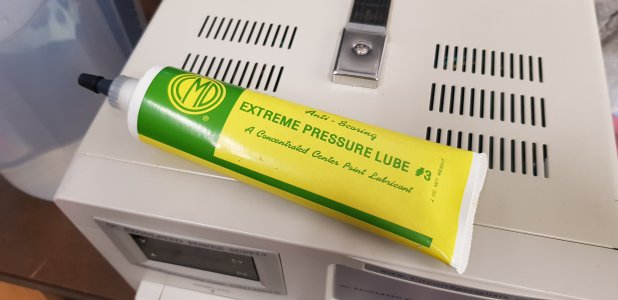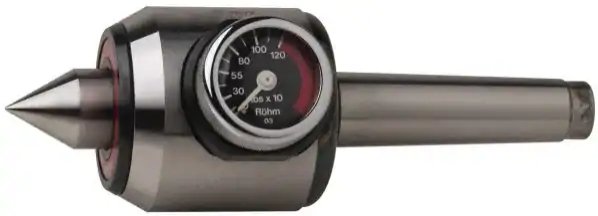-
Welcome back Guest! Did you know you can mentor other members here at H-M? If not, please check out our Relaunch of Hobby Machinist Mentoring Program!
You are using an out of date browser. It may not display this or other websites correctly.
You should upgrade or use an alternative browser.
You should upgrade or use an alternative browser.
Buying 90 or 82 zero flute counter sinks.
- Thread starter COMachinist
- Start date
- Joined
- Apr 29, 2019
- Messages
- 2,101
What Darkzero said
For a center a c'sink tool does not accurately follow the existing hole. You need a center to be accurate.
If the edge of the bore is wearing with a live center, then you are doing something wrong, there should be no movement between a live center and the work piece. If it is a large bore then at the time you are boring it you should cut the chamfer for your center at the same time, when you get to the bigger sizes not all centers are 60°.
For smaller sizes you should use a center drill, some times called a combination drill / c'sink. This will give an accurate location, the correct 60° angle and clearance for the tip of the center.
I have all the angles of c'sinks, 60°, 82°, 90°, 100°, and 120° but then I have been accumulating tools for a half century. Start by getting what you need for the job at hand, It is not a good way to spend to just get things for the sake of getting them, although getting a set of something is the best way to get things you do not have an imediate need for, Like a set of drill bits, I am sure that there are still a few drill bits that have never been used by me. I got a set of c'sinks and have used all of them at one time or another. Same with the set of center drills.
For a center a c'sink tool does not accurately follow the existing hole. You need a center to be accurate.
If the edge of the bore is wearing with a live center, then you are doing something wrong, there should be no movement between a live center and the work piece. If it is a large bore then at the time you are boring it you should cut the chamfer for your center at the same time, when you get to the bigger sizes not all centers are 60°.
For smaller sizes you should use a center drill, some times called a combination drill / c'sink. This will give an accurate location, the correct 60° angle and clearance for the tip of the center.
I have all the angles of c'sinks, 60°, 82°, 90°, 100°, and 120° but then I have been accumulating tools for a half century. Start by getting what you need for the job at hand, It is not a good way to spend to just get things for the sake of getting them, although getting a set of something is the best way to get things you do not have an imediate need for, Like a set of drill bits, I am sure that there are still a few drill bits that have never been used by me. I got a set of c'sinks and have used all of them at one time or another. Same with the set of center drills.
- Joined
- Nov 27, 2012
- Messages
- 7,872
Thank you, I've needed to turn things with large bores, and the live center looses tension from the lip of the bore moving/wearing on the point of the live center. If that makes sense.
As far as loosing tension, that could simply be the heating up & cooling of the part (and the center) causing that. When the part heats up, it will push the tailstock back (especially if you put too much tension), then when the part cools, not enough tension. If you are doing any considerable amount of turning supported by a center you should always check periodically for tension, especially when turning between centers. That's how I was taught.
As far as wear/scoring of the center's tip (if that's what you actually meant), even when I use a revolving center I always use lube on the tip & in the hole (I promise that was not meant to sound dirty!
This is what I use. I buy it from Mcmaster or MSC. I've read that machinists used to use white lead back in the day but of course that stuff is not available anymore.

- Joined
- Nov 27, 2012
- Messages
- 7,872
When the part heats up, it will push the tailstock back (especially if you put too much tension), then when the part cools, not enough tension.
BTW, the way I was taught, when using a revolving center, when sufficiently tensioned, you should still be able to turn the revolving tip by hand with the workpiece stationary, but not very freely, it should have a fair amount of resistance. If you apply so much force with the tailstock where you can't spin the center's tip at all, then that's too much. You're putting unecessary excessive load on the center's bearing(s) which will also cause excessive heat.
- Joined
- Apr 16, 2019
- Messages
- 745
That’s a neat looking tool to keep the countersunk holes the same . Im sure it’s $$$$ Has anyone made something similar?I have an aircraft countersink tool made by Martin aircraft tool really neat tool
- Joined
- Sep 1, 2020
- Messages
- 1,598
they are only 40 bucks used heres one for 25 bucks


Metalworking Countersinks for sale | eBay
Get the best deals on Metalworking Countersinks when you shop the largest online selection at eBay.com. Free shipping on many items | Browse your favorite brands | affordable prices.
www.ebay.com
- Joined
- Apr 14, 2014
- Messages
- 3,216
That’s a neat looking tool to keep the countersunk holes the same . Im sure it’s $$$$ Has anyone made something similar?
They come in many different sizes and can handle cutters to countersink holes anywhere from 1/8" diameter to over 2" in diameter. There are several different manufacturers. Most are surplus from aircraft manufacturers. They work fine, but do have some drawbacks. The cage limits how close you can come to an interfering corner or vertical member, and due to their length the are best used areas free of infringing obstacles. They are generally used in quick change air powered hand tools, but they do work well in a hand drill or drill press.
The cutting tips are screwed into a threaded shaft built into the cage. The smaller ones are 1/4-28 while the larger ones are up to 1/2". There are 2 styles. Either built in pilot or changeable pilot. The ones with the built in pilot require a hole at least the size of the pilot to be used. Those with a changeable pilot can be used either with or without the pilot. The piloted cutters are difficult to sharpen without the proper equipment. Those with the removable pilot can be sharpened on a surface grinder with a fixture. In many cases it's less expensive to replace the piloted ones than to send them out for sharpening.
I have about a dozen different sizes and around 100 different cutters. They come up on eBay for extremely reasonable prices every once in a while. If you're looking I would do a search and save it. You'll get notifications when new ones appear. Just be sure to make the search broad enough that you don't eliminate some manufacturers. Over the years they have been made by Magnavon, Zephyr, Briles, Wescon, Arvo Martin, ATI and many others. MA Ford, Briles and others make replacement cutters.
Keep in mind the standard countersink angle on these tools is 100*. Cutters are available in 45*, 60*, 82*, 90*, 100* and 120* as far as I know. The 100* are by far the most popular and least expensive.
They come in many different sizes and can handle cutters to countersink holes anywhere from 1/8" diameter to over 2" in diameter. There are several different manufacturers. Most are surplus from aircraft manufacturers. They work fine, but do have some drawbacks. The cage limits how close you can come to an interfering corner or vertical member, and due to their length the are best used areas free of infringing obstacles. They are generally used in quick change air powered hand tools, but they do work well in a hand drill or drill press.
The cutting tips are screwed into a threaded shaft built into the cage. The smaller ones are 1/4-28 while the larger ones are up to 1/2". There are 2 styles. Either built in pilot or changeable pilot. The ones with the built in pilot require a hole at least the size of the pilot to be used. Those with a changeable pilot can be used either with or without the pilot. The piloted cutters are difficult to sharpen without the proper equipment. Those with the removable pilot can be sharpened on a surface grinder with a fixture. In many cases it's less expensive to replace the piloted ones than to send them out for sharpening.
I have about a dozen different sizes and around 100 different cutters. They come up on eBay for extremely reasonable prices every once in a while. If you're looking I would do a search and save it. You'll get notifications when new ones appear. Just be sure to make the search broad enough that you don't eliminate some manufacturers. Over the years they have been made by Magnavon, Zephyr, Briles, Wescon, Arvo Martin, ATI and many others. MA Ford, Briles and others make replacement cutters.
Keep in mind the standard countersink angle on these tools is 100*. Cutters are available in 45*, 60*, 82*, 90*, 100* and 120* as far as I know. The 100* are by far the most popular and least expensive.





